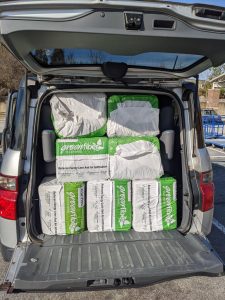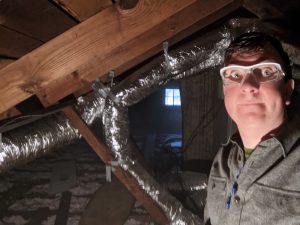Adventures in Efficiency: I Insulated My Own Attic

Fun fact, 20 bags of insulation will fit in a Honda Element. (Do not attempt.)
My partner and I moved into a 1925 house in Atlanta’s Edgewood Neighborhood back in May of 2019 – but the house was a bit of a mess, but I was in love and pressed forward to closing, extracting what concessions I could from the red flags contained in the inspection. A year later, I have no regrets about choosing this house that spoke to me so loudly, but my journey to becoming my parents is complete. The 9-year-old me would be horrified to learn that I’ve picked up my parents’ fondness for watching This Old House (now conveniently available in relevant bites on YouTube), and it was there that I arrived at the decision to forego professional help sealing up my drafty home, and to opt to blow in cellulose insulation myself.
A more diligent, determined person might be able to complete this project in a weekend, but between my aversion to phone calls, the impressive resistance shown by my local big-box home improvement stores’ employees, and the tiny little matter of an unprecedented global pandemic the time from estimating R-values to completing my project runs about 9 months. In the end I needed about 30 bales of the recycled newspaper based insulation (treated with a flame retardant) which put me well past the 20 bag requirement to receive the blower-machine for free for 24-hours. Long story short, I got some run-around from my neighborhood big-box home center where I purchased the insulation with the understanding that they’d lend me the blower. Whether true or not, every associate I was able to reach told me they did not have – and do not rent equipment. When I eventually found my way through the phone trees of several local stores to a willing employee, it was by then mid-March and that whole sort of thing was out of the question.
Fast forward to the first chilly week of October 2020 when my partner and I remembered the 30 cubes of insulation sitting in the attic. It was time. A confirmatory call to the Lowe’s in East Point indicated that the machine was available, and after a few false start Saturdays we eventually landed on a day. It only took an hour and a half for the hardware store to locate the correct paperwork, but with the help of a very diligent employee we finally had all the pieces.

For my dark attic I needed a head-lamp to see my work, but be aware that the cloud of dust will necessitate taking breaks to see clearly how much insulation you’ve deposited. Although this particular type is fiberglass-free “no-itch”, it always helps to wear gloves when working with insulation, as well as eye protection. The person operating the blower should wear hearing protection as the machine is rather loud. If your attic has exposed nails, some sort of hard hat is also advised.
Blowing insulation is a two-person job, but not a particularly difficult or time consuming one. Trading off with my partner every few bags insulation and allowing the dust to settle, we finished the task within 5 hours [including lunch!]. The blower came with a 100ft hose that was adequate to reach from the back deck almost to the front of the attic and blew a very inconsistent but usually ample stream of loosely fluffed particles. It was relatively easy to stay on my plywood rafts between joists and aim the stream of insulation just short of the rafter vents, around the ductwork, and below the various other obstructions where years of compaction had left the stud bays bare.
In the days since we finished the task, my anecdotal assessment is that the furnace kicks on far less than it used to. I’m gauging this by how many times I’m awoken during the night, aware that I’m suddenly spending money.








